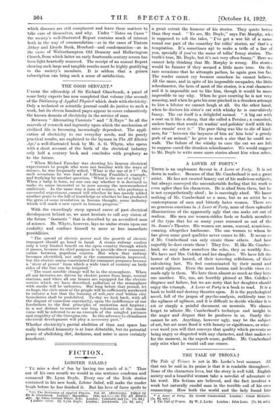THE PROTECTION OF ANCIENT BUILDINGS. THE current Report of the
Society for the Protection of Ancient Buildings* begins encouragingly :—
" The Annual Reports of the Society—which have followed each other without a break for forty-five years--are not only an interesting record of the buildings concerned, but also an invaluable commentary on the transformation of the Publics Mind with regard to the proper safeguarding of our national architectural inheritance. This transformation is very real in spite of a considerable residue of immovable ignorance, as of obstinate refusal to hear and be persuaded' among the better informed. This is not a matter of argument ; over the face of our ancient Architecture there has been written in unmistakable characters the accurate measure of what general understanding we have had of the meaning and value of these historic works of ancient Art. There are relatively very few old churches now left in England of which it can be said that they have during the last fifty or sixty years—the period par excellence, of Restoration '—been sympathetically maintained in their old essential structure or in their familiar and delightful appear- ance of solemn beauty ; while of the remainder—running into many hundreds of buildings big and little—we have but to look through the pages of any guide-book to become quickly familiar with the phrases thoroughly restored' or ' without interest' that follow the mention of many a once delightful village church. Now, when it is almost too late, a new spirit begins to show itself, notably in the pages of a number of able journals as well as in the vast mass of the private correspondence of the Society."
The ecclesiastical authorities are severely and deservedly reproached for past stupidities :— " While we were as a Nation confident that the guardianship of these national structures was in proper hands, it turns out to have been in very improper hands, and that the hearts and heads that should have guided it wisely were, as is clearly seen in the buildings themselves, empty of needful understanding as of real sympathy for ancient Architecture. To put it crudely in its bare and unhappy truth, one of the greatest spending bodies of our time, the Church, has given its thousands not to safeguarding the structures entrusted to them, but to making real mediaeval Architecture into sham-mediaeval Architecture."
We understand, however, that twenty-seven of the thirty-seven dioceses of England have now been shamed into setting up committees to consider the merits of any proposed alterations or repairs to church buildings. It would be interesting to know • 20 Buckingham Street. London. W.C. 2.
which dioceses are still complacent and leave these matters to take care of themselves, and why. Under " Notes on Cases " the society's well-illustrated Report contains much of interest both in the way of commendation—as in the cases of Tintern Abbey and Lloyds Bank, Hereford—and condemnation—as in the cases of Wolverhampton Old Deanery and Hullavington Church, from which latter an early fourteenth-century screen has been light-heartedly removed. The receipt of an annual Report showing such large and tangible results must be highly gratifying to the society's members. It is seldom that a guinea subscription can bring such a sense of satisfaction.



































 Previous page
Previous page